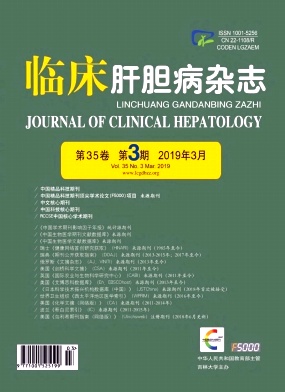|
[1] Nutritional status in cirrhosis. Italian multicentre cooperative pro-ject on nutrition in liver cirrhosis[J]. J Hepatol, 1994, 21 (3) :317-325.
|
|
[2] CAREGARO L, ALBERINO F, AMODIO P, et al. Malnutritionin alcoholic and virus-related cirrhosis[J]. Am J Clin Nutr, 1996, 63 (4) :602-609.
|
|
[3] European Association for the Study of the Liver. EASL clinicalpractice guidelines on nutrition in chronic liver disease[J]. JHepatol, 2019, 70 (1) :172-193.
|
|
[4] National Workshop on Fatty Liver and Alcoholic Liver Disease, Chinese Society of Hepatology, Chinese Medical Association;Fatty Liver Expert Committee, Chinese Medical Doctor Associ-ation. Guidelines of prevention and treatment for alcoholic liverdisease:A 2018 update[J]. J Prac Hepatol, 2018, 21 (2) :170-176. (in Chinese) 中华医学会肝病学分会脂肪肝和酒精性肝病学组, 中国医师协会脂肪性肝病专家委员会.酒精性肝病防治指南 (2018年更新版) [J].实用肝脏病杂志, 2018, 21 (2) :170-176.
|
|
[5] SINGAL AK, BATALLER R, AHN J, et al. ACG clinical guide-line:Alcoholic liver disease[J]. Am J Gastroenterol, 2018, 113 (2) :175-194.
|
|
[6] European Association for the Study of the Liver. EASL clinicalpractice guidelines:Management of alcohol-related liver dis-ease[J]. J Hepatol, 2018, 69 (1) :154-181
|
|
[7] FAN JG. Epidemiology of alcoholic and nonalcoholic fatty liverdisease in China[J]. J Gastroenterol Hepatol, 2013, 28 (Sup-pl 1) :11-17
|
|
[8] FAN JG, ZHU J, LI XJ, et al. Prevalence of and risk factorsfor fatty liver in a general population of Shanghai, China[J]. JHepatol, 2005, 43 (3) :508-514.
|
|
[9] BELLENTANI S, SACCOCCIO G, MASUTTI F, et al. Preva-lence of and risk factors for hepatic steatosis in Northern Italy[J]. Ann Intern Med, 2000, 132 (2) :112-117.
|
|
[10] MEHTA M, SATSANGI S, DUSEJA A, et al. Can alcoholic liv-er disease and nonalcoholic fatty liver disease co-exist[J].J Clin Exp Hepatol, 2017, 7 (2) :121-126.
|
|
[11] RAYNARD B, BALIAN A, FALLIK D, et al. Risk factors of fi-brosis in alcohol-induced liver disease[J]. Hepatology, 2002, 35 (3) :635-638.
|
|
[12] STEPANOVA M, RAFIQ N, YOUNOSSI ZM. Components ofmetabolic syndrome are independent predictors of mortality inpatients with chronic liver disease:A population-based study[J]. Gut, 2010, 59 (10) :1410-1415.
|
|
[13] National Workshop on Fatty Liver and Alcoholic Liver Disease, Chinese Society of Hepatology, Chinese Medical Association;Fatty Liver Expert Committee, Chinese Medical Doctor Associ-ation. Guidelines of prevention and treatment for nonalcoholicfatty liver disease:A 2018 update[J]. J Prac Hepatol, 2018, 21 (2) :177-186. (in Chinese) 中华医学会肝病学分会脂肪肝和酒精性肝病学组, 中国医师协会脂肪性肝病专家委员会.非酒精性脂肪性肝病防治指南 (2018年更新版) [J].实用肝脏病杂志, 2018, 21 (2) :177-186.
|
|
[14] CHALASANI N, YOUNOSSI Z, LAVINE JE, et al. The diagno-sis and management of nonalcoholic fatty liver disease:Prac-tice guidance from the American Association for the Study ofLiver Diseases[J]. Hepatology, 2018, 67 (1) :328-357.
|
|
[15] RUHL CE, EVERHART JE. Joint effects of body weight and al-cohol on elevated serum alanine aminotransferase in the Unit-ed States population[J]. Clin Gastroenterol Hepatol, 2005, 3 (12) :1260-1268.
|
|
[16] AJMERA V, BELT P, WILSON LA, et al. Among patients withnonalcoholic fatty liver disease, modest alcohol use is associ-ated with less improvement in histologic steatosis and steato-hepatitis[J]. Clin Gastroenterol Hepatol, 2018, 169 (9) :1511-1520.
|
|
[17] CHANG Y, CHO YK, KIM Y, et al. Nonheavy drinking andworsening of non-invasive fibrosis markers in nonalcoholicfatty liver disease:A cohort study[J]. Hepatology, 2019, 69 (1) :64-75.
|
|
[18] CHANG B, XU MJ, ZHOU Z, et al. Short-or long-termhigh-fat diet feeding plus acute ethanol binge synergisticallyinduce acute liver injury in mice:An important role for CXCL1[J]. Hepatology, 2015, 62 (4) :1070-1085.
|
|
[19]BERG F, HELENIUS-HIETALA J, PUUKKA P, et al. Bingedrinking and the risk of liver events:A population-based co-hort study[J]. Liver Int, 2017, 37 (9) :1373-1381.
|
|
[20] LOOMBA R, YANG HI, SU J, et al. Synergism between obe-sity and alcohol in increasing the risk of hepatocellular carcino-ma:A prospective cohort study[J]. Am J Epidemiol, 2013, 177 (4) :333-342.
|
|
[21] ASCHA MS, HANOUNEH IA, LOPEZ R, et al. The incidenceand risk factors of hepatocellular carcinoma in patients withnonalcoholic steatohepatitis[J]. Hepatology, 2010, 51 (6) :1972-1978.
|
|
[22] GBD 2016 Alcohol Collaborators. Alcohol use and burden for195 countries and territories, 1990-2016:A systematic analy-sis for the Global Burden of Disease Study 2016[J]. Lancet, 2018, 392 (10152) :1015-1035.
|
|
[23]BERG F, HELENIUS-HIETALA J, PUUKKA P, et al. Inter-action between alcohol consumption and metabolic syndromein predicting severe liver disease in the general population[J]. Hepatology, 2018, 67 (6) :2141-2149.
|
|
[24] RATZIU V, GHABRIL M, ROMERO-GOMEZ M, et al. Rec-ommendations for management and treatment of nonalcoholicsteatohepatitis[J]. Transplantation, 2019, 103 (1) :28-38.
|
|
[25] SOOKOIAN S, PIROLA CJ. How safe is moderate alcoholconsumption in overweight and obese Individuals?[J]. Gas-troenterology, 2016, 150 (8) :1698-1703.
|
|
[26] AJMERA VH, TERRAULT NA, HARRISON SA. Is moderate al-cohol use in nonalcoholic fatty liver disease good or bad? Acritical review[J]. Hepatology, 2017, 65 (6) :2090-2099.
|
|
[27] DUNN W, CHALASANI N. Advice regarding alcohol use by in-dividuals with nonalcoholic fatty liver disease:Primum non no-cere[J]. Hepatology, 2019, 69 (1) :9-11.
|
|
[28] DUNN W, ANGULO P, SANDERSON S, et al. Utility of a newmodel to diagnose an alcohol basis for steatohepatitis[J].Gastroenterology, 2006, 131 (4) :1057-1063.
|
|
[29] CEROVIC'I, MLADENOVIC'D, JEˇS IC'R, et al. Alcoholic liverdisease/nonalcoholic fatty liver disease index:Distinguishingalcoholic from nonalcoholic fatty liver disease[J]. Eur J Gas-troenterol Hepatol, 2013, 25 (8) :899-904.
|







 DownLoad:
DownLoad: